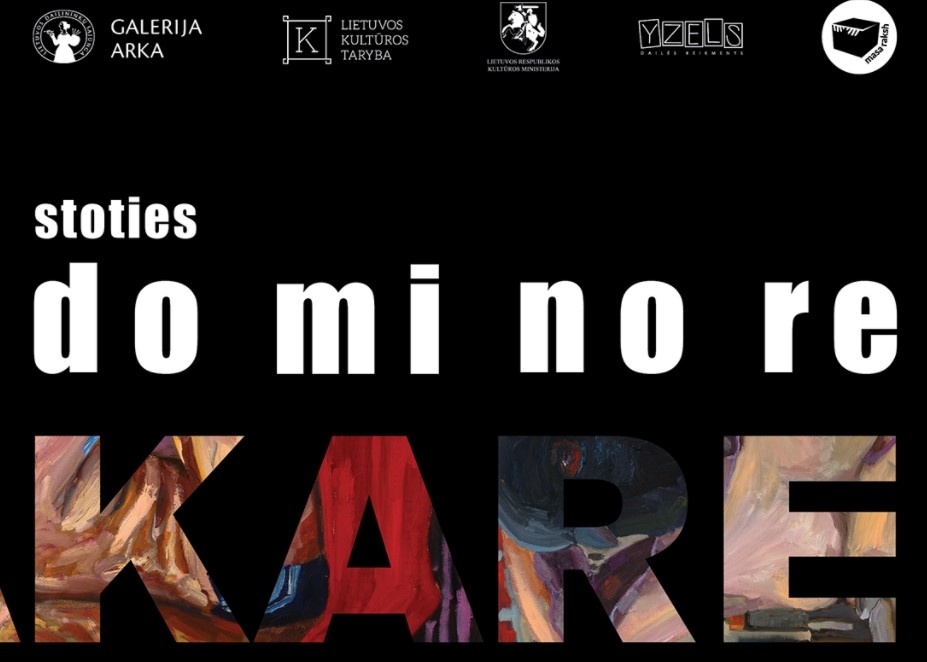With the artist after his call, without committing anything until I saw the paintings, I spontaneously agreed to meet at his home. Such new apartment buildings in Vilnius are now being built, if not in the sleeping quarters, then at least between villas and cottages, on green streets or on the outskirts of the city. Here, between warehouses and workshops, this house is a foreign body. The window of the house offers views of the railway carriages. One of the three small rooms in the cozy apartment has been turned into a painter’s workshop, from which larger canvases have to be moved to the living room for display. Arriving in Vilnius from Pabradė, Makarevičius did not study at the Academy of Arts, but at the Pedagogical University, so we are both meeting for the first time, but it is easy to communicate with him. He is sincere and open, with no manifestations of bravado or artificial postures. Having reviewed the list of exhibitions of the young artist, I am pleasantly surprised at how actively he takes advantage of every opportunity to exhibit his paintings. After graduating, he participated in thirty-eight group performances and organized as many as forty-nine personal exhibitions in recognized and improvised exhibition spaces throughout Lithuania. Out of the need to exchange ideas and act with peer artists, together with Inga Mrazauskaitė in 2019, he founded the group SinThesis Gang.
Painting in such conditions is cramped, but everything is redeemed by the enthusiasm of the young artist and the authenticity of his plots and ways of expression.
The motives of social reality are interpreted sarcastically, the focus on the domestic genre connects the young painter with tradition. The last origins are in the 17th century. Dutch Jan Steen, Adriaen Brouwer, Adrian van Ostade in the tavern stages as in the twentieth century. in the streets, cafes, cabaret of the artists of the Weimar Republic in the twenties. Parallels can also be traced back to the 20th century. neo-expressionist paintings by a group of painters in Poland in the eighties, in which historical threads intertwine grotesquely with actualities.
Makarevičius approaches the traditions of Lithuanian painting primarily through his lecturers at the Pedagogical University: Professors Ričardas Bartkevičius and Linas Liandzbergis. Like Bartkevičius, the young painter continues the traditions of neo-expressionist realism, as well as choosing thickened colors and a distorted contour line, Makarevičius creates short, witty performances of the surrounding reality in his paintings. Only where the teacher uses everyday household items does Makarevic go out into the city and focus on the people. Liandzberg’s influence is not so much directly revealed, but is also traced through bright, even sharp color combinations and an interest in collage-based motif composition. Still today, Makarevich has already managed to find his own plots and ways of expression.
The painter Andrius Makarevičius (b. 1982) found his own theme – the everyday life of Vilnius station and its accesses, the place where he lives and became. He curiously observes and comments on the uninterrupted action in the station itself, in the square in front of it and in the surrounding streets, gates, courtyards, divination parlors, pubs, shops, along the chains of warehouses, trolleybuses, bus stops as well as in the parking lots. The artist carefully captures the facades of buildings, signs, graffiti on the walls and characteristic interior details. Makarevich pays even more attention to the environment than people. The characters in the plots of his paintings are not so much casual passers-by or passengers as his residents and visitors are closely associated with the quarter.
The plot, the authenticity of the environment, the characters and the events are very important to Makarevic. At the same time, he gives his stories an emotional character. The starting point of the pictures is a close observation of reality, but this is reflected emotionally. The painter uses inventive compositions, unexpected viewing angles and an expressive manner of painting and bright colors. He enriches expressionist realism with cartoon, grotesque and even surreal elements. Objects and figures become flat, almost unmodelated, and often surrounded by a rough black contour line.
At the chronicle center of Makarevičius station district, the usual activities are in discos, sports clubs, shopping places, near eateries, in carriages, as well as in exceptional events – police raids, weddings. The painter depicts both individual people and multi-figure scenes. He is most interested in characters from marginalized social strata. The painter seems to enjoy observing their way of life: semi-illegal trade in “flying carpets” – fostering stall muscles and holiday rituals and props. The artist accurately depicts the
characteristic gestures and posture of these characters, as well as the colorful unrefined style of casual and casual wear.
In the “Quarantine Self-Portrait”, the artist does not distinguish himself from the heroes of his paintings. In the workshop, unlike these, he does not wear training, but does not romanticize himself or anything. His naked body behind the paint table looks firm and rough, and his facial features are simply erased. In previous exhibitions “Stories of the Station District”, as well as in the latest “Station DOMINORE” in the “Arka” gallery, Makarevičius manages to convey the lively and rough atmosphere of this place with its special rhythms and smells. Makarevich tells in pictures: emotionally, cheerfully and understandably for everyone, so we can expect the success of his paintings.
Prof. Curator of the exhibition
Andrius Makarevičius (b. 1982) is a Lithuanian painter living and working in Vilnius. The artist is an active participant in the visual arts scene, having already organized more than forty solo exhibitions and participated in more than thirty group projects. 2019 together with Inga Mrazauskaite founded the artist group SinThesis Gang. From 2017 LDS member. Art studies in 2005 graduated from Vilnius Pedagogical University.
Curator of the exhibition:prof. Raminta Jurėnaitė




